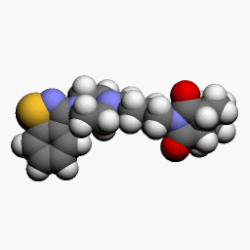Perospirone
 |
|
 |
|
| Clinical data | |
|---|---|
| Trade names | Lullan |
| AHFS/Drugs.com | International Drug Names |
| Routes of administration |
Oral |
| ATC code |
|
| Legal status | |
| Legal status |
|
| Pharmacokinetic data | |
| Protein binding | 92% |
| Metabolism | Hepatic |
| Biological half-life | 1.9-2.5 hours |
| Excretion | Renal (0.4% as unchanged drug) |
| Identifiers | |
|
|
| CAS Number | |
| PubChem CID | |
| IUPHAR/BPS | |
| ChemSpider | |
| UNII | |
| Chemical and physical data | |
| Formula | C23H30N4O2S |
| Molar mass | 426.57 g/mol |
| 3D model (Jmol) | |
|
|
|
|
|
|
|
Perospirone (Lullan) is an atypical antipsychotic of the azapirone family. It was introduced in Japan by Dainippon Sumitomo Pharma in 2001 for the treatment of schizophrenia and acute cases of bipolar mania.
Its primary uses are in the treatment of schizophrenia and bipolar mania.
In a clinical trial that compared it to haloperidol in the treatment of schizophrenia it was found to produce significantly superior overall symptom control. In another clinical trial perospirone was compared with mosapramine and produced a similar reduction in total PANSS score, except with respect to the blunted affect part of the PANSS negative score, in which perospirone produced a significantly greater improvement. In an open-label clinical trial comparing aripiprazole with perospirone there was no significant difference between the two treatments discovered in terms of both efficacy and tolerability. In 2009 a clinical trial found that perospirone produced a similar reduction of PANSS score than risperidone and the extrapyramidal side effects was similar in both frequency and severity between groups.
A meta-analysis published in 2013 found that it is statistically significantly less efficacious than other second-generation antipsychotics.
Has a higher incidence of extrapyramidal side effects than the other atypical antipsychotics, but still less than that seen with typical antipsychotics. A trend was observed in a clinical trial comparing mosapramine with perospirone that favoured perospirone for producing less prominent extrapyramidal side effects than mosapramine although statistical significant was not reached. It may produce less QT interval prolongation than zotepine, as in one patient who had previously been on zotepine switching to perospirone corrected their prolonged QT interval. It also tended to produce less severe extrapyramidal side effects than haloperidol in a clinical trial comparing the two (although statistical significance was not reached).
...
Wikipedia
